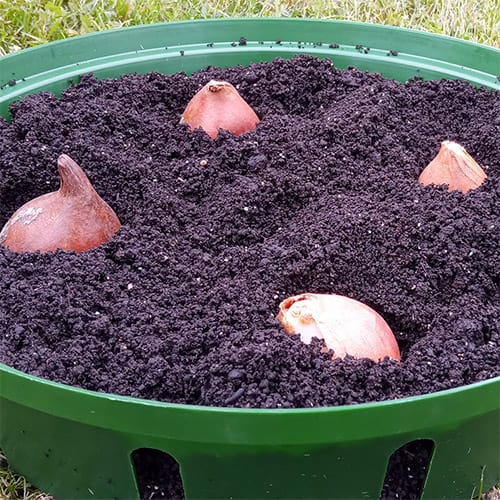How to:
Plant Spring
Bulbs
At this time of year, Spring is just a distant splash of colour. However October is the month that many gardeners really start to plan for the months ahead. A little time spent now will reward you with beds, borders and containers full of much needed colour.
Bulbs are easy to plant and represent great value, with the right bulbs adding colour and texture to any garden. These versatile plants can be brighten a lack lustre corner of the garden or even naturalise lawns with a gentle drift of colour. With only a few bulbs you can still make an impact which will last for years to come.
Make a little go a long way
We can’t all afford to buy hundreds of bulbs to make a statement feature in the garden. With as little as 10 bulbs, you can plant up a feature that will get bigger and better each year. Find our current selection of Bulbs here.
Choose a border or even a winding path and divide the bulbs into two sets of 3 bulbs and one set of 4 bulbs.
Work out your spacing, starting by placing 3 bulbs grouped together at the nearest point. Move along to the next point and place a further 3 bulbs, again grouping together to create a tight clump. Plant the final 4 bulbs at the end of the sightline, to help give more impact as the perspective diminishes.
The same principle works when planting larger numbers of bulbs in a lawn. Naturalising lawns and areas sheltered by trees is another great way of creating swathes of colour in otherwise lacklustre areas.
Scatter bulbs to create a natural spread, increasing the numbers the further away from the viewing point you get.


Using Bulb Baskets
Bulbs can be planted as either permanent or temporary features for your garden. The easiest way by far to plant for a temporary feature is by using a bulb basket. We stock several varieties that can be found here.
They are ideal for using in containers or borders where you will want to lift the bulbs after flowering to make way for new bedding plants. Simply place the basket at the desired depth for the bulbs then place the bulbs in before covering in soil.
Using a basket allows for their easy removal and less chance of leaving a stray bulb in the ground. Once lifted they can be dried and stored ready for planting next season.
If you are planting in this way then use a specialist bulb fertiliser which will encourage strong root growth. These are usually rich in mycorrhizae which helps build up roots as well as release the soils natural nutrients.
Planting tips
The general rule to follow is to dig a hole for your bulbs that is two to three times the depth of the bulb.
Always make sure that when planting the bulbs the base of the bulb touches the bottom of the hole to avoid any air pockets. This removes the chance of water pooling underneath them during wet periods and rotting the bulb from the base up.
Bulbs planted in containers are great for being able to move the colour around as different bulbs come into bloom. As one container fades simply swap it over for another one which is about to flower to extend the show of colour.
If you are planting into a lawn then you can dig out the turf using a knife or bulb planter, pop the bulb in then replace the turf.
Alternatively try using a knife or trowel to make an angled cut in the turf which can then be partially lifted. This allows you to place the bulb at the base of the cut before setting the turf back in place.


Cooking with colour
Another popular planting technique for containers is to make a bulb ‘lasagne’. This involves planting your bulbs in layers starting with the largest bulbs first. The depth of planting is guided by the size of the bulb, so by carefully choosing anywhere up to 4 different sized bulbs, you can make your bulb lasagne. This is a great way to mix larger and smaller bulbs together to create maximum impact in a small space.
When to plant
Broadly speaking you can start planting out spring flowering bulbs from September onwards. Bold coloured daffodils, fragrant hyacinths and the elegant iris are all ideal for planting from early autumn onwards. Smaller bulbs such as crocus are ideal for planting in drifts across a lawn as the soil starts to cool down. Plant tulips from late October to December as they are more prone to disease so should be planted. The colder weather during these months is cool enough to inhibit viral and fungal diseases.
Once the planting is done then you can sit back and relax while the bulbs work their magic, out of sight, in readiness for those crisp spring months.
A keen gardener and a member of the Elixir Gardens team for nearly 2 years, I'll be sharing tips and tutorials on a variety of growing and horticultural projects. Learn about planting up, crop maintenance, weeding and other essential gardening jobs in my monthly blog posts.
Graham
A keen gardener and a member of the Elixir Gardens team for nearly 2 years, I'll be sharing tips and tutorials on a variety of growing and horticultural projects. Learn about planting up, crop maintenance, weeding and other essential gardening jobs in my monthly blog posts.
Graham
Copy the code below for your 10% off discount:
ELIXIR10

Share This Blog
Featured Products
-

Epsom Bath Salts | 25kg Pharmaceutical FCC Food Grade Bag | Magnesium Sulphate
£28.99 Add to basket -

Sodium Bicarbonate (250g-25kg Bags & Tubs)
£4.98 – £48.99 Select options This product has multiple variants. The options may be chosen on the product page -

Himalayan Organic Pink Salt | Fine & Coarse Grade
£4.19 – £29.99 Select options This product has multiple variants. The options may be chosen on the product page -

Organic Epsom Bathing Salts (100% Pure FCC Food Grade) 500g-25kg
£5.99 – £41.99 Select options This product has multiple variants. The options may be chosen on the product page -

Dead Sea Bath Salt (Magnesium Rich) 500g-25kg
£5.29 – £57.99 Select options This product has multiple variants. The options may be chosen on the product page






